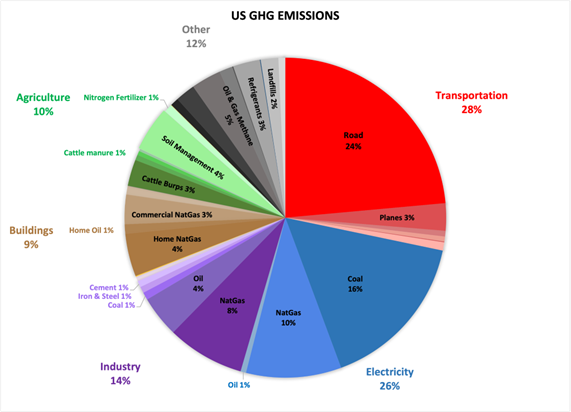How #ElectrifyEverything meshes with CCL’s goals
By Dana Nuccitelli, CCL Research Coordinator
Electrification is a hot topic right now, with many countries searching for ways to reduce their dependence on Russian oil and gas as Putin’s war atrocities in Ukraine worsen by the day. Fortunately, many of the solutions to reduce long-term fossil fuel financial flows to the Russian government by pursuing an “electrify everything” strategy can also serve to address the climate crisis.
The plan comprises two steps: 1) decarbonize our electricity supply, and then 2) fuel as much of the economy as possible with that clean electricity. Fortunately, step 1 is already happening, with nearly 80% of new electricity being installed in America this year coming from clean sources. The second step – switching to electric technologies – is critical to curbing both dependences on fossil fuels from abusive regimes and climate change.
Keishaa Austin, Head of Engagement and Partnerships at Rewiring America, touched on these points in CCL’s April national call. CCL also wrote a blog post about her perspective on electrifying everything. Let’s dive a little deeper into the details about how expanding electrification and efficiency can solve a variety of important problems, how the campaign can be advanced, and what CCL volunteers can do to help.
Why electrify everything?
The recent Intergovernmental Panel on Climate Change (IPCC) report found that future greenhouse gas emissions from fossil fuel infrastructure that’s already in place or in the planning stages are enough to use up the entire remaining Paris target carbon budget. Simply put, to keep global warming below 2°C we have to transition away from fossil fuels immediately. Building additional oil and gas and coal infrastructure means either missing the Paris targets or decommissioning power plants, refineries, and pipelines early, leading to potentially trillions of dollars in “stranded assets” that won’t be able to fully recoup their investment costs.
But fossil fuels power every corner of the economy, from transportation (mostly cars and trucks) to buildings (mostly space and water heating and cooking) and industrial processes. The good news is that most of these applications have cleaner, more efficient electric replacement options available.

Sources of US greenhouse gas emissions. Data from the US EPA; chart created by Dana Nuccitelli
Deploying those electric alternatives would reduce dependence on Russian oil and gas, minimize stranded fossil fuel assets, and curb greenhouse gas emissions. But they would also yield numerous other benefits. Electrification yields cleaner air, improving people’s health especially in marginalized communities that are frequently located near big sources of dirty pollution, as well as lessening indoor air pollution that causes childhood asthma. It also improves energy security and price stability, because electricity is made in America and has much more stable prices than the fossil fuels that are subject to a global market. And it would help protect against future inflation, which as we’re seeing right now is often driven by those same unstable fossil fuel prices.
How do we electrify everything?
The availability of electric solutions varies by sector. For transportation, electric vehicles are a great alternative. The IPCC reported that battery costs have plummeted by 85% over the past decade. Research has shown that due to the high efficiency of EVs and the growth of renewable energy, 94% of Americans now live in areas where driving an EV produces lower emissions than a 50-mile-per-gallon gasoline car. Electrifying trucks and buses in addition to cars, as well as reducing driving are also important measures to reduce transportation emissions.
For buildings, fossil fuels are often used to provide heat. About two-thirds of buildings’ direct fossil fuel use heats indoor spaces, another quarter heats water, and the rest is used for cooking or drying laundry or industrial heating. Replacing fossil fuel furnaces and boilers and water heaters are thus key steps to decarbonize buildings. This transition can be achieved by deploying electric heat pumps that transfer heat very efficiently from the surrounding environment and can provide both heating and cooling services from a single unit. Replacing gas stoves can also help cut building carbon emissions while providing the added benefit of cleaner indoor air, reducing cases of childhood asthma and other adverse health effects. Improving building energy efficiency is another important and cost-effective solution for this sector.
Some industrial processes can be electrified (like using electric arc furnaces to make steel from scrap), but electrification is less suitable for other industrial applications, so a range of solutions will be needed to decarbonize this sector.
How can CCL help?
A carbon pollution price would improve the cost competitiveness of electric solutions relative to their fossil fuel counterparts, so CCL’s long advocacy for this policy is helpful to the “electrify everything” movement. A carbon price would accelerate electrification and efficiency efforts.
Up-front costs also often pose a key barrier to the implementation of electric solutions. Although they might break even or save money over their lifetimes due to higher efficiency and lower fuel costs, EVs and heat pumps and induction stoves generally have higher initial purchase costs than their fossil fuel counterparts. This barrier can be overcome through point-of-sale rebates and other subsidies, which are particularly important for helping lower-income households afford these solutions. Electrification also requires infrastructure improvements: homes often need electrical panel upgrades, and EV adoption requires that sufficient charging stations be available to meet the increased demand.
State and local governments often offer these sorts of rebates. Many cities have also implemented gas bans and electrification codes for new buildings – policies that save money for home builders and owners while reducing carbon and indoor air pollution, but which are politically controversial.
The bipartisan Infrastructure Investment and Jobs Act passed last year invested tens of billions of dollars in the electric grid and EVs and their charging infrastructure that are now being deployed. The climate provisions currently being considered by Congress as part of the budget reconciliation process include many more investments to accelerate electrification – EV and heat pump subsidies, funding for home electrification and efficiency programs, expanding EV charging infrastructure, and public transit. CCL volunteers are encouraged to contact their representatives to remind them of the importance of passing these climate provisions and ideally also a carbon fee and dividend through the reconciliation process this year.
As the IPCC has just warned, time is running out to make this transition. The longer we delay, the higher the costs will become to the climate, the economy, domestic security, and to Americans’ health. This is an electric opportunity that we can’t afford to miss.
Dana Nuccitelli is an environmental scientist and climate journalist with a Master’s Degree in physics. He has written about climate change since 2010 for Skeptical Science, for The Guardian from 2013 to 2018, and since 2018 for Yale Climate Connections. In 2015 he published the book “Climatology versus Pseudoscience”, and he has also authored ten peer-reviewed climate studies, including a 2013 paper that found a 97% consensus among peer-reviewed climate science research that humans are the primary cause of global warming.





